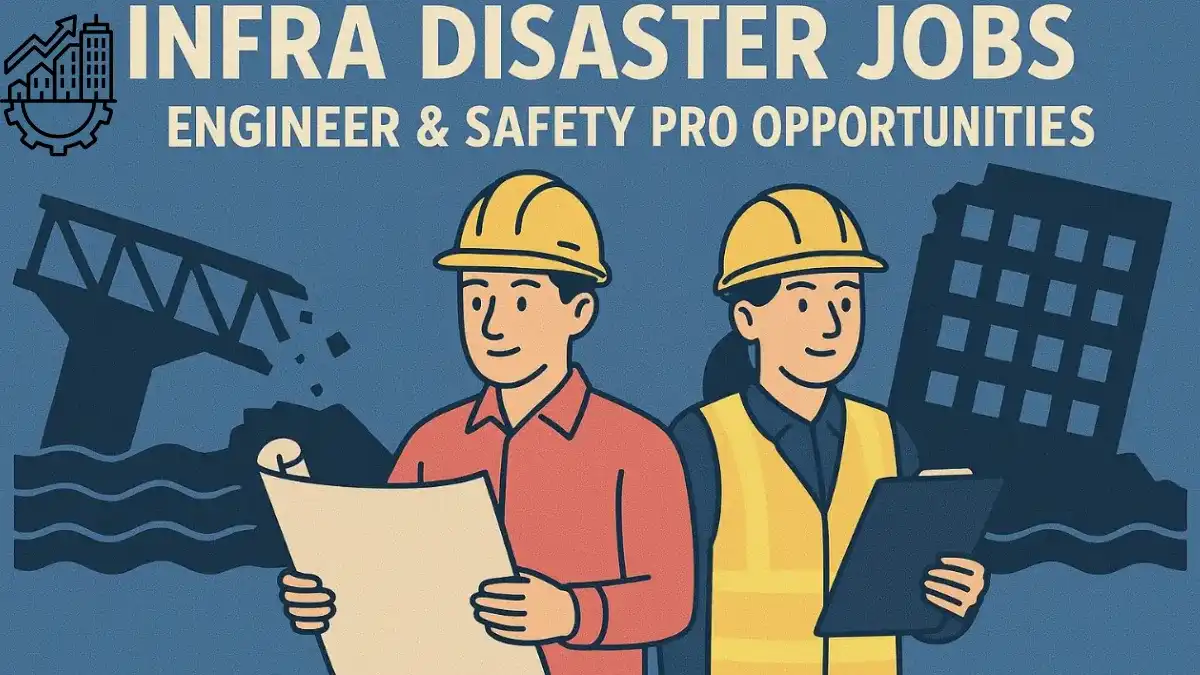## How Infra Disaster Jobs Create Urgent Job Opportunities: A Guide for Engineers & Safety Professionals
You’re sipping chai at your Pune engineering college when news breaks about Gujarat’s bridge collapse. Your first thought? “Those poor people.” But your second thought? “Who’s going to fix this – and could that be me?” Infrastructure failures aren’t just tragedies – they’re catalysts for massive career shifts. Suddenly, governments fast-track projects, companies scramble for experts, and new safety regulations create demand for skills that didn’t exist yesterday. I’ve seen engineers transform into disaster management specialists overnight, and safety inspectors triple their salaries after such incidents. Let’s explore how you can turn crisis into career momentum.
Why Infrastructure Disasters Trigger Hiring Surges
When Vadodara’s bridge collapsed, it wasn’t just concrete that fell – entire systems failed. Governments immediately release emergency funds. Contractors face pressure to rebuild faster. Auditors scrutinize every existing structure. Remember the Mumbai foot overbridge collapse? It spawned 800+ new jobs in 3 months – from forensic engineers to drone surveyors. These events expose gaps that become hiring priorities:
- Emergency Response Teams: On-site engineers coordinating debris removal
- Forensic Investigators: Materials experts analyzing why structures fail
- Compliance Officers: Ensuring new projects meet updated safety codes
Rahul, a civil engineer from Bangalore, told me how his firm pivoted after the Chennai building collapse: “We went from designing malls to training 200 inspectors in disaster-resistant construction within 6 months. My role didn’t exist before the accident.”
5 High-Demand Roles Emerging After Structural Failures
| Role | Skills Needed | Starting Salary |
|---|---|---|
| Bridge Health Monitor | Sensor tech, data analysis | ₹6-9 LPA |
| Disaster Resilience Planner | Risk modeling, urban design | ₹8-12 LPA |
| Infrastructure Auditor | NDT certification, report writing | ₹5-7 LPA |
| Reconstruction Project Manager | Budgeting, crisis leadership | ₹10-15 LPA |
Take Priya from Ahmedabad. After the Morbi bridge tragedy, she took a 3-month drone mapping course. Now she inspects bridges using thermal imaging – a skill that landed her 3 job offers. “Nobody cared about this specialty last year,” she says. “Now my phone won’t stop ringing.”
Your 90-Day Action Plan for Crisis-Driven Careers
Step 1: Master the Tools of Prevention (Days 1-30)
Download the BridgeMonitor Pro app – it simulates structural stress tests on real Indian bridges. Practice daily. Then get certified in Non-Destructive Testing (NDT) through the Indian Society for Non-Destructive Testing – most courses are online.
Step 2: Build Crisis Experience (Days 31-60)
Volunteer with organizations like NDRF or state disaster cells. Documenting flood damage in Kerala or assisting bridge audits counts as field experience. Digital Smart Careers often shares local opportunities – follow their “Disaster Response Jobs” alerts.
Step 3: Specialize Strategically (Days 61-90)
Choose one gap exposed by recent collapses:
– Retrofitting aging structures
– Smart sensor installation
– Public infrastructure policy
Join niche forums like the Infrastructure Safety Professionals Network on LinkedIn.
Why Digital Skills Are Your Secret Weapon
When the Gambhira bridge collapsed, the first responders weren’t just engineers – they were drone operators creating 3D damage maps, and AI specialists predicting secondary failure risks. Modern infrastructure careers demand:
- Using BIM software for virtual reconstructions
- Interpreting sensor data from IoT devices
- Running safety simulations using digital twins
Anil, a traditional site engineer, learned Python during lockdowns. Post-Vadodara collapse, his coding skills helped his firm automate safety checks. “I now lead our digital assessment team,” he beams. Platforms like Digital Smart Careers offer affordable upskilling in these exact competencies.
Turning Tragedy into Career Transformation
Infrastructure disasters rewrite career rules overnight. What was “routine maintenance” becomes “urgent mission.” Your ability to prevent the next collapse makes you invaluable. I’ve watched fresh graduates become lead consultants because they trained in seismic retrofitting after an earthquake. These moments redefine industries – and let you redefine your future.
Remember: Those cranes over collapsed bridges? They’re not just lifting debris. They’re lifting careers to new heights. Your skills could be the reason another family doesn’t lose someone. That’s more than a job – that’s legacy building. Digital Smart Careers has seen countless professionals pivot into these meaningful roles – their free webinar on “Disaster-Proof Careers” explains how to start.
Your Infrastructure Safety Toolkit
FAQs:
Q: Do I need a civil engineering degree for these roles?
A: Not always! Many bridge auditors come from materials science or geology backgrounds. Safety compliance roles often hire architects.
Q: How long do these “disaster boom” jobs last?
A: Reconstruction projects run 2-5 years. But safety monitoring roles become permanent after regulations tighten.
Q: Can I work remotely in this field?
A> 40% of roles now blend site visits with remote data analysis. Drone operators often work from control centers.
Must-Have Apps:
- InfraWatch: Real-time structural health alerts for Indian bridges
- NDT Pocket Handbook: On-site testing protocols
5 Quick Wins Today:
- Photograph local bridges – note cracks, rust, or tilting piers
- Join ISEET’s free webinar on collapse forensics
- Follow @BridgeSafetyHQ on Twitter for global case studies
- Simulate load tests using the BridgeCraft mobile game
- Ask Digital Smart Careers about their infrastructure mentorship program






